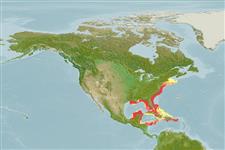Environment: milieu / climate zone / distribuzione batimetrica / distribution range
Ecologia
marino; salmastro demersale; distribuzione batimetrica 0 - 183 m (Ref. 26268), usually 1 - 30 m (Ref. 26268). Subtropical; 45°N - 15°N, 94°W - 65°W (Ref. 26268)
Western Atlantic: New York south through the Florida Keys (USA), through the northern Gulf of Mexico to the Campeche Peninsula, Mexico, the Bahamas, and Cuba.
Length at first maturity / Size / Peso / Age
Maturità: Lm 10.1, range 8 - ? cm
Max length : 21.0 cm TL maschio/sesso non determinato; (Ref. 52683)
Raggi dorsali molli (totale) : 85 - 92; Raggi anali molli: 69 - 72. Eyed side dark brown, sometimes with narrow bars; large blackish patch on opercle.
Body shape (shape guide): elongated.
Very abundant in shallow coastal waters and estuaries. Found on soft muddy bottoms. Feeds mainly on small benthic invertebrates, principally small crabs, polychaetes, copepods, amphipods and ostracods.
Robins, C.R. and G.C. Ray, 1986. A field guide to Atlantic coast fishes of North America. Houghton Mifflin Company, Boston, U.S.A. 354 p. (Ref. 7251)
IUCN Red List Status (Ref. 130435: Version 2025-1)
Threat to humans
Harmless
Human uses
Pesca: scarso interesse commerciale
Strumenti
Special reports
Download XML
Fonti Internet
Estimates based on models
Preferred temperature (Fonte Biblio.
123201): 17.7 - 27.9, mean 24.4 °C (based on 406 cells).
Phylogenetic diversity index (Fonte Biblio.
82804): PD
50 = 0.5000 [Uniqueness, from 0.5 = low to 2.0 = high].
Bayesian length-weight: a=0.00457 (0.00370 - 0.00565), b=3.19 (3.13 - 3.25), in cm total length, based on LWR estimates for this species (Ref.
93245).
Trophic level (Fonte Biblio.
69278): 3.2 ±0.40 se; based on food items.
Resilienza (Fonte Biblio.
120179): Medio, tempo minimo di raddoppiamento della popolazione 1.4 - 4.4 anni (tmax=5; K=0.6;).
Fishing Vulnerability (Ref.
59153): Low to moderate vulnerability (32 of 100).
🛈
